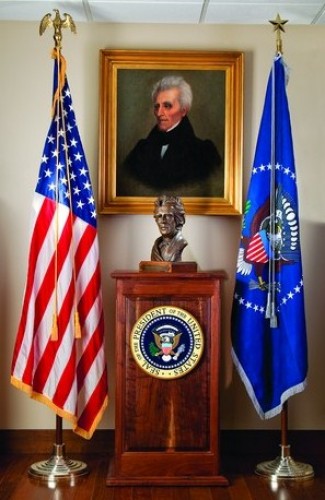

ANDREW JACKSON by William Stewart Watson (Scottish 1800-1870). (27x23/ oil: signed lower right “Stewart Watson/Pinxt 1836”)
Watson is believed to have painted in both America and Europe for several years before settling in Edinburgh. Hs is primarily known for his portraits ,including miniatures, and painting of historical subjects.
According to family history, this portrait of President Andrew Jackson (1767-1845) was given to Colonel Albert James Pickett (1810-1858) by President Jackson when Pickett visited Jackson at The Hermitage in 1837.
Albert Pickett was a prominent writer and Alabama historian who was influential in Alabama politics during the second quarter of the 19th century starting in 1832. At the age of 18, Pickett was sent to New England for his education, including military school in Middletown, Connecticut, though by 1830 he returned to Alabama where he studied law with his brother. In 1832, he married Sarah Smith Harris, with whom he had twelve children.
While Jacksonian Democrats had won control of the Alabama State Legislature, a group of Anti-Jackson States Rights legislators nonetheless were successful in 1835 in endorsing Judge Hugh White of Tennessee for Presidency over Martin Van Buren. A Jacksonian Democrat, Pickett was instrumental at this point in effectively organizing a political response which resulted in the repeal of White’s endorsement. As a result of his loyalty, the seventh President of the United States presented Pickett with this portrait.
Col. Pickett eventually gave the portrait to his daughter, Mary Pickett Harris and it descended through her family. The great grandchild of Mary Pickett Harris consigned the portrait with Christies in 2001 where it was acquired by a Tennessee collector, who later sold it to a prominent Texas collection.
The bust, ANDREW JACKSON, is the original artist’s proof (ed. 100 by Grisham, 1996). It was acquired from The Hermitage Collection in 2003.
